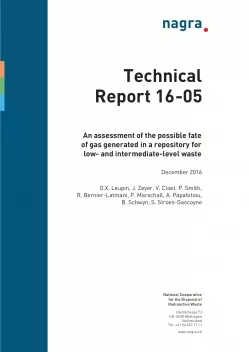
Technical Report NTB 16-05
An assessment of the possible fate of gas generated in a repository for low- and intermediate-level waste
The present study provides an assessment of reactions that result in a gas pressure reduction –also called gas sinks – in a generic deep geological repository for low- and intermediate-level waste in Opalinus Clay. Both chemical reactions and microbial activity may contribute to or reduce gas pressure build-up. A complete synopsis is given, comprising the current state of chemical, microbial and geoscientific understanding of gas generation and consumption in a L/ILW repository.
The degradation of organic materials (by both microbial and chemical reactions) and the anoxic corrosion of metals will generate various gaseous products such as hydrogen, carbon dioxide, methane, hydrogen sulphide and ammonia. Some of these gas species are expected to further react with materials present at the point of origin. More particularly, carbon dioxide and hydrogen sulphide are expected to react entirely with e.g. cement, water or iron. Thus, they do not contribute to a gas pressure build-up in the repository. The remaining gas species – mainly hydrogen, methane and small amounts of ammonia – are assumed not to react at the point of origin and can thus contribute to gas pressure build-up.
Gas pressure build-up in the L/ILW emplacement caverns will result in gas migrating through the gas permeable seals and through the excavation-damaged zone to reach the operational and construction tunnels where microorganisms may utilise the gas and thus reduce gas pressure build-up. In order to allow bacteria to thrive over longer periods, the backfill material of the operational tunnel needs to have sufficient porosity and a porewater composition for favourable living conditions. Experimental findings at the Mont Terri underground rock laboratory show that bacteria found in borehole water are efficient at oxidising hydrogen as long as sulphate is present in the borehole water.
Examples from nature and engineered underground structures provide supporting evidence that these assumptions are reasonable. These analogues show that microbial activity in the subsurface can take place over long periods (hundreds to thousands of years) and at a large scale (millions of cubic metres of gas converted).
For assessing the potential impact of gas sinks on the gas pressure development, mass balance calculations were carried out and transport models run. The results show that the transport of sulphate from the host rock to the various backfilled tunnels is a limiting factor in the conversion of the hydrogen. If, on the other hand, the backfill is an additional source of sulphate (e.g. due to the addition of gypsum), then microorganisms can utilise it and impact the gas pressure build-up accordingly.
